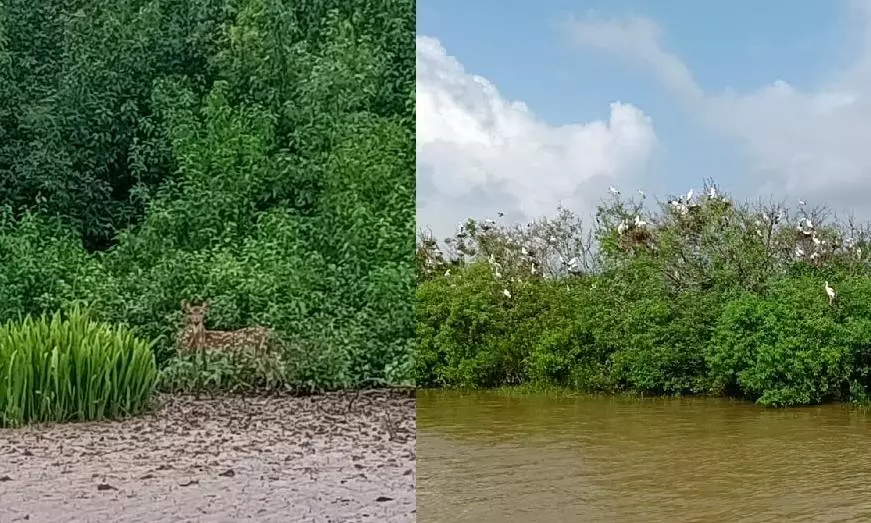Will Nature's Mangrove Defense Wall Save Bhitarkanika from Cyclone Dana's Fury?

Bhubaneswar: As Cyclone Dana barrels toward the Odisha coast, poised to make landfall between Bhitarkanika and Dhamra on Thursday evening or early Friday morning, an unsettling calm hangs over the region.
Coastal communities brace themselves, waiting with bated breath as the India Meteorological Department (IMD) warns of potential devastation.
Bhitarkanika, located in Odisha’s Kendrapara district, is home to the famous Bhitarkanika National Park, a biodiversity hotspot teeming with wildlife, including crocodiles, snakes, and a stunning array of bird species. Neighboring Dhamra, in Bhadrak district, is a hub of economic activity with its major sea port and bustling fishing jetty, which serves as a lifeline for thousands of fisherfolk.
But as Dana draws near, all eyes are on Bhitarkanika’s natural defense: a sprawling 200-square-kilometer expanse of mangrove forests. These ancient trees stand as nature’s shield against the wrath of the sea, providing critical protection from cyclonic winds and storm surges.
Nature's Fortress: The Mangrove Shield
Mangroves, with their complex root systems, have long been recognised as vital guardians of coastal ecosystems. Their ability to reduce wind speeds, absorb tidal energy, and prevent coastal erosion makes them an invaluable buffer. In Bhitarkanika, 62 species of mangroves, including Avicennia, Bruguiera, Heritiera, and Rhizophora, form a protective wall, silently bracing for Dana’s impact.
These forests not only protect human lives and livelihoods but also shelter a diverse range of species. Bhitarkanika is home to 215 bird species—among them kingfishers, Brahminy ducks, and white-bellied sea eagles—as well as reptiles like the Indian python, king cobra, and the endangered saltwater crocodile. Mammals such as jackals, wild boar, and the elusive fishing cat also roam its grounds.
However, with Cyclone Dana threatening winds of over 120 km/h and tidal surges, the park’s rich biodiversity is at grave risk. Local officials are on high alert, anticipating disruptions to both wildlife and human communities.
A Race to Protect Wildlife
“We have mobilized two rescue teams, each consisting of seven members, to monitor and protect key species like snakes and crocodiles, which may leave the sanctuary and wander into human settlements after the cyclone,” said Rajnagar Divisional Forest Officer (DFO) Sudarsan Gopinath. “These teams will also keep a close eye on other creatures, such as deer and hare.”
The fear is that high-velocity winds and storm surges could displace not only animals but also entire ecosystems, leaving both wildlife and human populations vulnerable.
The Lifesaving Power of Mangroves
For years, experts have underscored the importance of mangroves in mitigating the effects of natural disasters. Their dense root systems bind and stabilize the soil, reducing coastal erosion. The above-ground roots act like natural speed bumps, slowing water flow and promoting sediment deposition. This helps protect against floods and storm surges that would otherwise sweep through unimpeded.
But mangroves offer more than just physical protection. Their complex roots filter pollutants from water, improving overall water quality, and they act as significant carbon sinks—storing three to five times more carbon per area than tropical rainforests. This “blue carbon” plays a crucial role in combating climate change, especially as storms like Dana become more frequent and intense.
What’s at Stake?
Beyond the immediate threat to life and property, Cyclone Dana presents a profound challenge to the ecological balance of Bhitarkanika. The mangroves that protect this region are not just a defense mechanism—they are part of an intricate web of life that sustains countless species, from the mighty saltwater crocodile to the delicate kingfisher. Should the cyclone's fury overwhelm these defenses, the impact on the park’s biodiversity could be devastating.
As the storm looms, the people of Odisha, and especially those in Bhitarkanika and Dhamra, can only hope that nature’s mangrove wall will once again stand strong against the unrelenting forces of the Bay of Bengal. But with the increasing threat of climate change, the future remains uncertain. The question lingers: will these mangroves continue to protect, or will they, too, fall victim to the storm?
As Cyclone Dana inches closer, the fate of Bhitarkanika’s rich ecological treasures hangs in the balance.
